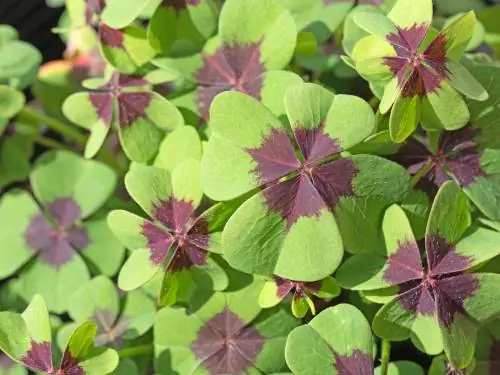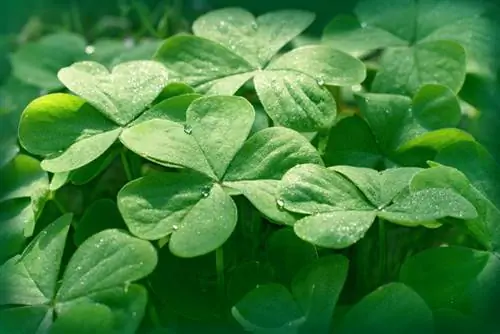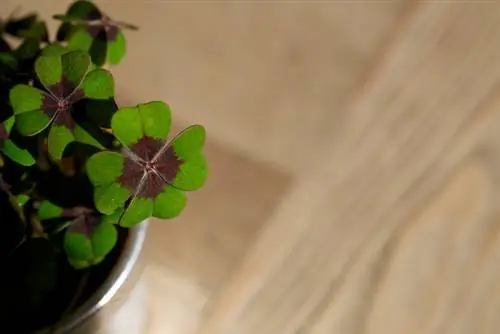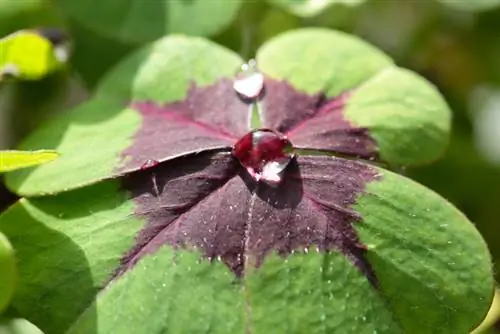- Author admin [email protected].
- Public 2024-01-05 20:48.
- Last modified 2025-01-23 11:19.
Lucky Clover Many people are familiar with the small flower pot arrangements with chimney sweeps and pigs that are sold in abundance on New Year's Eve as a motivator to start the new year. The pretty plant is also very popular as an ornamental plant. In addition, lucky clover is used as a powerful symbol in a wide variety of industries.
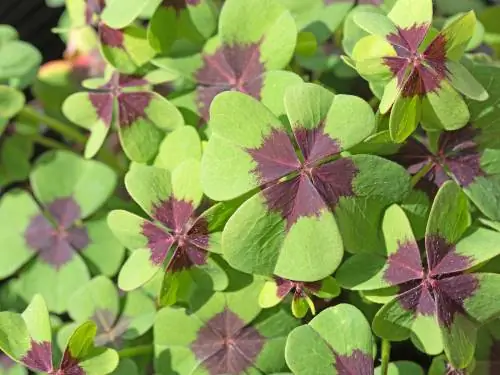
Botanical portrait of the lucky clover
The lucky clover, botanically Oxalis tetraphylla, is a species from the wood sorrel genus - so it has nothing to do with real clover species. A second, not quite as symbolic common name is four-leaf sorrel.
In this country, the attractive plant is very popular as a house and outdoor plant - and not without reason: the lucky clover has a high decorative value with its two-tone leaves in fresh green and burgundy red to purple in the middle. But what makes it even more likeable for many plant lovers is its strong association with happiness. After all, its leaves are basically fingered in four parts - and four-leaf clovers are, as we know, the ultimate symbol of good luck.
The ornamental value of lucky clover also comes from other of its growth properties:
- Leaf shape: inverted triangular shape, heart-shaped due to an indentation at the front edge, very fine, gentle structure
- Leaf size: 20 to 65 cm
- Stems: fine, dark petioles
- Special features: Leaves always align sensitively with the light and fold up in the dark
In April and June, the lucky clover produces another pleasing ornament in addition to its beautiful foliage: the long-stemmed, pink to scarlet flowers are just as delicate as the foliage with delicate, five-fold funnel-shaped inflorescences that stand together in false umbels. After flowering and a phase of regeneration, small, pointed capsule fruits are formed containing tiny seeds.
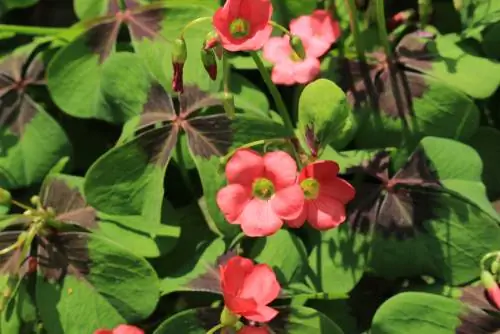
Lucky clover has beautiful red flowers
Lucky clover is a perennial and grows between 15 and 40 cm high. It grows from bulbs from which a completely underground shoot arises. So the lucky plant comes back every year. Oxalis tetraphylla originally comes from Mexico. The German naturalist Ferdinand Deppe discovered it there. The species has now also become wild in Europe as well as in Asia, Africa and Australia.
Excursus
Clover and milk
Did you know that lucky clovers not only appear in playful handicrafts, but also have something to do with the elite of haute couture? In fact he has, with none other than fashion czar Karl Lagerfeld. The Hamburg-born designer was the son of Otto Lagerfeld, a condensed milk manufacturer whose entrepreneurial creation was the so-called Glücksklee-Milch GmbH. After initially importing canned milk from America with his company Lagerfeld & Co, Lagerfeld Sr. founded his own brand called 'Glücksklee' in 1923. This was a leader in the canned milk sector for a long time. Today the Glücksklee brand belongs to Hochwald Foods GmbH, which has several milk, cream, condensed milk and cheese producing brands such as Bärenmarke, Lünebest, Elinas or Hochwald as well as for Private labels such as ja!, K-Klassik or TIP.
Species and varieties
Lucky clover forms its own species within the sorrel family and is not related to the white clover that is all too familiar from garden lawns. But with the dark-leaved horn sorrel (Oxalis corniculata), which, like white clover, is considered an annoying weed in the lawn. There are only a few special cultivars of Oxalis tetraphylla. A white-flowering and unusual variety is Oxalis tetraphylla Alba. The Iron Cross variety is quite common and is characterized by a particularly dark, purple central pattern on the leaves.
How do you care for lucky clover?
Lucky clover is not only a very attractive plant visually - its relatively mundane care requirements also make it an extremely pleasant roommate for many beginners. If you think a little about your location, water and light requirements, you can even continue to successfully cultivate a small New Year's Eve plant.
Let's first provide a brief overview of the most important care measures. Below you will find everything explained in detail again.
| Location | Substrate | Pouring | Repotting | Wintering | Propagate |
|---|---|---|---|---|---|
| very bright, best at the window, rather cool in winter (10 to 15°C), preferable outside in summer, not too dry air | humous, permeable soil | Watering moderately, always allow the pot ball to dry superficially before watering, significantly reduce or stop watering in winter (if overwintered as a tuber) | only necessary if the pot has become too small, preferably in spring | either with or without an above-ground part of the plant: with stems and leaves in a cool, bright place, water moderately, for overwintering as a retracted tuber: stop watering completely from August. Overwintering is also possible outdoors with a certain risk | 1. By division method: divide onion bulbs in spring or (for growing around New Year's Eve) in late summer/autumn and place in substrate 2. By sowing: collect and sow seeds in autumn 3. by cutting method: cut cuttings, preferably in spring and in water or Let the soil take root |
Location
As a location, lucky clover prefers a bright, light-filled place, both in summer and winter. If you receive a pot of lucky clover with chimney sweeps, ladybirds, etc. as a gift, it's best to put it in a window where it gets enough light. Otherwise it will quickly let the leaves hang.
Also make sure that theambient air is not too dry. If the heating is on heavily, you can place a bowl of water in the room to evaporate. Basically, the lucky clover should be kept cooler during the winter than at the usual living temperature, around10 to 15°CIf you have a window seat in an unheated stairwell or cold house, you should overwinter your lucky clover there.
In summer the lucky clover wants to go outside. You can place it in a pot on the terrace or balcony or plant it in a bed. Choose a sunny, sheltered spot for him there.
From my lucky clover? from last New Year's Eve? has become a beautifully flowering large plant again. My clover always gets a large pot at the end of January and is allowed outside at the end of April. From June onwards the clover fills the entire pot and blooms really nicely. But it is not allowed to stand in the sun. I can now enjoy my lucky clover until the first frost.. ?????????????????. garden instagardeners weather sun gardenlove gardenhappiness gardendecoration gardendeco gardenideas gardendesign gardendesign plants flowers blossommagic blog instagarten gardenjoy travemünde lübeck arianesideenwelt klee blossoms arianeskreativwerkstatt garden gardendesign gardeninspiration luckybringer luckyclover
A post shared by Ariane Ruschinski-Altemüller (@inarianesgarten) on Jul 21, 2019 at 3:46pm PDT
Substrate
It is best to plant a lucky clover in humus-rich, permeable soil. To loosen the substrate, add some sand.
Pouring
Lucky clover should not be watered too much. If you keep it too wet, you may well ruin it. So only give it new water when the surface of the pot ball has dried out. Of course, this happens faster in summer than in winter. During the cold season, reduce watering to the bare minimum.
Repotting
A lucky clover rarely needs to be repotted. It's only time for a new pot if the old one has become too cramped and the root ball looks gnarled and worn out. The best time to repot is early spring. Take the bulbs out of the old pot and place them in a larger planter filled with fresh, loamy soil loosened with sand. It then takes around 6 to 8 weeks until sprouting.
Wintering

While wood sorrel is very hardy, lucky clover cannot tolerate sub-zero temperatures
Instead of overwintering it in the room with its pretty foliage, you can also let the lucky clover move in and bring it over the winter as a bulb. This eliminates the need for care - but also the beautiful sight and the encouraging factor at the turn of the year. If you want to let the plant overwinter as a tuber, simply stop watering in the fall. In the spring the pot is then placed back in the light and gradually watered so that the clover sprouts again.
Lucky clover is only partially hardy. Normally, even if you overwinter it as a planted tuber, you should not expose it to double-digit temperatures below zero. If you have planted it outdoors, there is no guarantee that it will come back next year. If there are no longer frost periods with temperatures below -10°C, you have a good chance.
Propagate
To propagate a lucky clover plant, you can use the following three methods:
- Division
- Sowing
- Cuttings
Division
As a bulbous plant, the easiest way to propagate lucky clover is via the division method. You can use these either in spring or in late summer/early autumn. Late summer is a good time for division propagation if you want to use the lucky clover as a souvenir for friends in time for New Year's Eve. To do this, it is no longer watered from late summer onwards, so that the above-ground part of the plant moves in. From September you can take the tubers out of the ground and divide them. Place the divided tuber parts in pots with fresh soil. Water the divided and planted tuber regularly and place the pot in a bright location.
Sowing
Alternatively, you can also propagate lucky clover by sowing. To do this, collect the small seeds from the capsule fruits in late summer and sow them directly in autumn. This way you can also grow plants for New Year's Eve.
Cuttings
The plant can also be propagated via cuttings. This is possible all year round. However, it is best to cut cuttings in spring. You can root them in a glass of water or directly in a moist soil substrate.
Tip
When it comes to propagation, a small word of warning needs to be said: if you plant the lucky clover outdoors and live in a warm region with mild winters, it can spread a lot and become a burden. Its tubers form strong runners, which means it multiplies quickly underground.
Buy lucky clover
If you would like to purchase an Oxalis tetraphylla specimen, you can of course buy a ready-grown lucky clover in a pot. Depending on where you do this, the growing conditions may make it difficult to continue cultivating at home.
Quickly prepared mini pot arrangements can be found in every supermarket on New Year's Eve, including discounters such as Lidl, Aldi or Netto. You can also find undecorated, larger specimens in the plant centers of hardware stores such as Obi, Hagebaumarkt and Co.
Tip
Moving to a different environment - i.e. to your home - is always somewhat stressful for the lucky clover. Be particularly attentive the first time after purchase: if the leaves hang, gently adjust the environmental conditions: with more light, cooler temperatures and higher humidity.
If you would like to grow your own lucky clover and avoid moving problems, you can also buy bulbs or seeds. Both are offered in specialist shops and especially by seed mail order companies, mostly also on the Internet.
The high symbolism of the lucky clover
Lucky clover is not only beautiful to look at, its four-part pinnate leaves are also highly symbolic. While quartered leaves are rarely found on common white clover, they are the norm on lucky clover. What is a rarity with real types of clover is available here in abundance. It is therefore not surprising that the plant is considered a great lucky charm.
In Celtic times, four-leaf clovers were said to have magical power, the activation of which was the responsibility of the high spiritual leaders, the Druids.
The four-leaf clover is also a central symbolic image in the Christian faith. It represents both the cross and the four evangelists. In the biblical story of creation, it is also a four-leaf clover that Eve carries with her as a souvenir when she is banished from the Garden of Eden. According to this legend, the four-leaf clover also has a piece of paradise attached to it.
In the Middle Ages, the four-leaf clover was widespread as a good luck charm in Christian and pagan cultures. People often liked to carry such a valuable piece of paper with them, especially on uncertain ventures: when traveling, for example, it was customary to sew one into their clothing.
Lucky clover as a gift

The lucky clover is a beautiful, symbolic gift
To make your friends and relatives happy at the turn of the year, you can also create your own versions of the typical lucky clover pots from the supermarket. With cuttings from your plant and an individual selection of decorations, the standard New Year's Eve souvenir gets a much more personal touch.
All other well-known symbols of good luck, such as a chimney sweep figure, a lucky penny, a piggy, a ladybug, a horseshoe or a fly agaric, can of course be used as decorative objects to encourage the start of the new year. You can find such symbols in the form of figures made from various materials such as chenille wire, wood, plastic, raffia or foam in craft supply stores or in supermarkets with larger, well-stocked household goods departments. Of course, if you have good hands and enjoy creative crafts, you can also make such decorative figures yourself.
Your New Year's Eve lucky clover will of course become even more personal if you design it beyond these usual decoration ideas. For example, with symbols that match the individual plans of the recipient. Figures or pictures that remind you of special goals you have set can be a nice gesture and provide a lot of motivation.
Of course, lucky clover is also suitable as a gift on occasions other than New Year's Eve. After all, on your birthday you also wish good luck, confirmations and communions, weddings or housewarming celebrations herald a new phase of life, for which happiness, courage and cheerfulness can be needed just as much as at the beginning of a new calendar year.
Lucky clover as a decorative symbol
The pretty, heart-shaped shape of the large individual feathers and their green-burgundy color have made lucky clovers a popular emblem on everyday objects. Zippers on zippers or buttons on clothing, purses or bags are often decorated with the contours of a four-leaf clover. The almost round shape is ideal for this.
A young brand from the German company Dernier, which sells elegant, urban leather bags and wallets for women, has dedicated itself entirely to the popular lucky plant with the name 'Glüxklee'. A metal pendant in the shape of a lucky clover leaf serves as the brand emblem for many products.
For handicrafts, lucky clovers are also a very popular decorative motif - also against the symbolic background of the medieval custom of sewing into traveling clothes. The typical four-leaf clover shape is often used as cute nubs on knitted sweaters for children, as a row pattern on borders, and as an original shape for crocheted pot holders or coasters. In handicraft books and in DYS forums on the Internet you can find numerous instructions and templates for knitting, crocheting, painting, crafting or drawing.
Here is a nice video tutorial for a simple, very decorative crochet cloverleaf:

Creative activities involving the lucky clover leaf are also a lot of fun for children: the symmetrical arrangement of the heart-shaped leaf shape offers many opportunities to try out color arrangements. This is why you often find the shamrock motif in coloring pages or coloring pictures.
Of course, the four-leaf clover has long since arrived in the digital realm. In any clipart archives you can always find a cloverleaf template for inserting into homepages, electronic greeting cards or invitations that, in the broadest sense, have to do with luck, nature or a happy future.
If you want to let luck get directly under your skin, you can get a lucky clover leaf tattoo - a practical thing for the cautious among the tattoo fans, who have become more numerous today, because such a small leaf motif is not big, you can in inconspicuous parts of the body and can develop its own personal effect there.
Frequently asked questions
Is lucky clover poisonous?
No, lucky clover is not poisonous to humans, cats or other pets. However, its leaves contain oxalic acid, which should not be consumed in large quantities. If a curious four-legged friend or a small child takes greater pleasure in literally ingesting happiness, you may want to place the plant out of reach.
Can you eat lucky clover?
Lucky clover is not only non-toxic, but even edible. You can eat both its leaves and especially the onion. Because of their oxalic acid content mentioned above, consumption of the leaves must be limited to a small amount. But there's nothing wrong with a decorative, original salad garnish with a few pretty leaves.
The lucky clover onion can easily be used for culinary purposes. If you dig them up and let them dry, you can prepare them in a similar way to carrots.
Is lucky clover hardy?
Only to a limited extent. If you plant your lucky clover in the summer and the winters in your region do not tend to have long periods of double-digit minus temperatures, the lucky clover can survive the winter outdoors. Overwintering it in a cold house or room is safer.
What does lucky clover have to do with milk?
This association is only vague for some of the younger generation, because the best days of the canned milk brand Glücksklee, founded by Karl Lagerfeld's father Otto Lagerfeld, are over. Nowadays, people are simply less likely to use condensed milk and are also more likely to use soft packaging. For a long time, lucky clover condensed milk was the market leader in Germany.

